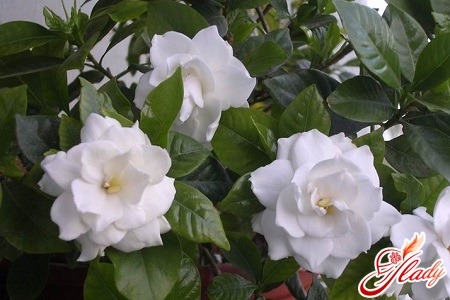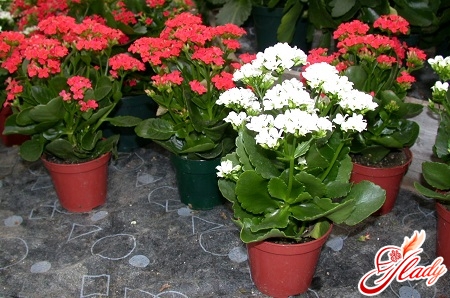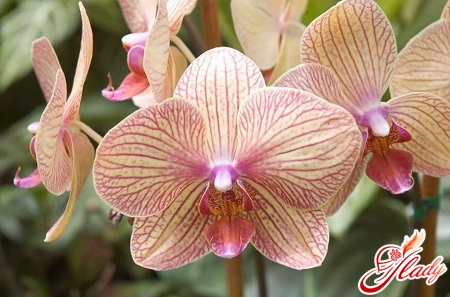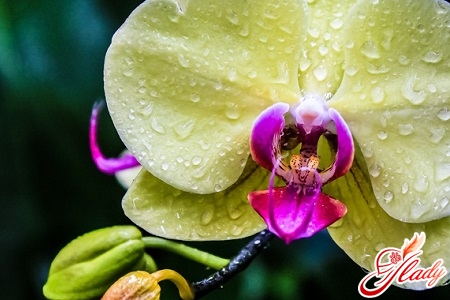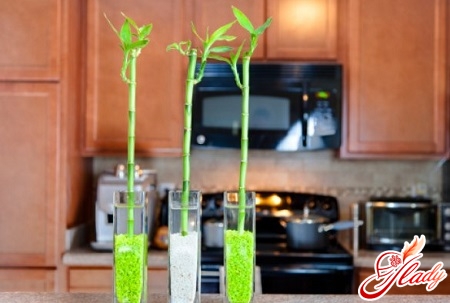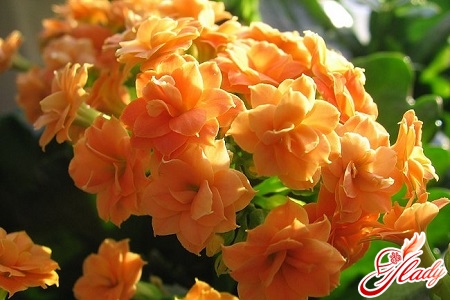 There lives in our houses one amazing guest fromSouth Africa, and his name is Kalanchoe. In total there are about 200 species of this amazing plant. Among them there are viviparous and decorative-deciduous breeds. Some species are very successfully used in folk and traditional medicine (especially in cosmetology and for treating colds) And all thanks to the bactericidal properties of the flower. Today we will talk about one of the most common species of this plant - the Kalanchoe degramon. He is often confused with a very close relative - a pinnate calanchoe, although under conditions of detention such confusion is practically not reflected.
There lives in our houses one amazing guest fromSouth Africa, and his name is Kalanchoe. In total there are about 200 species of this amazing plant. Among them there are viviparous and decorative-deciduous breeds. Some species are very successfully used in folk and traditional medicine (especially in cosmetology and for treating colds) And all thanks to the bactericidal properties of the flower. Today we will talk about one of the most common species of this plant - the Kalanchoe degramon. He is often confused with a very close relative - a pinnate calanchoe, although under conditions of detention such confusion is practically not reflected.
Appearance
Its popularity has not only won the Kalanchoebecause of unpretentious conditions of detention, but also because of its amazing way of reproduction. This flower grows to half a meter in height. Its leaves are fleshy and oblong, with jagged edges. In the indentations between the denticles there are brood buds, from which the babies are formed. They grow directly on the mother plant and have their own roots. If such a baby falls on the soil, it instantly takes root and a young flower begins to develop. This species of Kalanchoe has only one stem, which does not give branches. Depending on the conditions of the leaves, the Degremona leaves can reach 24 centimeters in length. They are shiny, full of green color with light blue. In a perfectly healthy plant, the leaves grow strictly upward, and the jagged edges are slightly wrapped inwards. The trunk at the Kalanchoe is rather fragile and needs support, with time the lower leaves have the property of falling off, so that the trunk is bare. 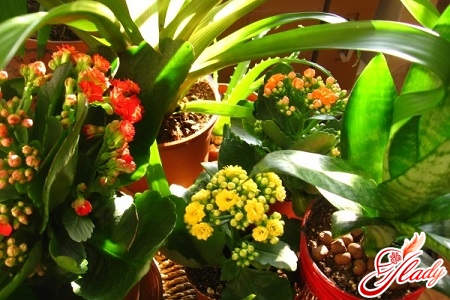
Features of care and cultivation
In general, this unpretentious plant does not needin special care. Given that the homeland of the Kalanchoe is still the tropics, he loves well-lit and ventilated places. But it is desirable to avoid direct sunlight. This species is much more suitable for diffuse light, otherwise the leaves will acquire a dark color with a reddish tint, and the plant itself will begin to dry out. The optimal daytime temperature is 20-23 degrees, at night it is allowed to lower the temperature within reasonable limits. In winter, the ambient temperature should not fall below 15 degrees. Kalanchoe loves airing, but does not tolerate a cold draft, so keep it in appropriate conditions. In the summer, the pot with the plant can be safely planted in the garden or on an open veranda - he will definitely like it there. However, during a rain or fog a flower is better to bring into the house. Watering and fertilization During the period of active growth, which occurs during the warm season, watering should be moderate. Do not allow excessive drying of the soil in the pot, but it is not necessary to water it too. Make sure that before watering the ground is rather dry. You can feed the plant in spring and summer. It is enough to use one additional fertilizer per month with any universal fertilizer for succulents. In the cold season, Kalanchoe Degremona does not need additional feeding. Transplant Young plants are transplanted annually. The pot is selected in accordance with the size of the plant, it is usually 1-2 centimeters larger than the previous one. As a primer, you can either buy the usual mixture for succulents, or make the right mixture yourself. To do this, you will need:
- 1 part of sod land;
- 1 part leaf;
- 1 part peat;
- 1 part of crumb of sand and expanded clay.
Also in the ground you can add a bit of brickcrumbs and birch coals. In the future, the plant is transplanted when it reaches a height of 40-50 centimeters. At this time, it loses its appeal, the top is usually cut and rooted in a new pot. Reproduction Almost all the work on reproduction of the flower will perform on its own. Young shoots are on the mother plant for several weeks, then they fall to the ground, where they themselves take root. At this time it is desirable to collect them, but you can leave. Then several growing Kalanchoe will look more picturesque. Do not get rid of all the young shoots. Old plants grow very quickly as they grow, they will have to be updated periodically. Does Kalanchoe bloom degramon? A lot of people know that this kind of Kalanchoe is also blooming. And, nevertheless, grown plants can please the flowers of their owners in the beginning of autumn or winter. Inflorescences are tubular flowers of orange or pink color, which rise above the leaves in the form of a crown. Sometimes the peduncles can grow to 30 centimeters in height. During flowering, be sure to take care of the support. For flowering, the plant needs a long night and a short day. If you create such conditions, the plant will bloom repeatedly, only note that when there is a lack of light, the Kalanchoe has a habit of stretching. Possible problems The appearance on the leaves of dry brown spots indicates the content in a cold and humid room, and the appearance of gray mold - about the excess of moisture and heat. Kalanchoe is often affected by aphids, which can be removed with the help of various drugs sold in stores. You can resort to folk methods, for example, treat the plant with a soap solution. After a day, the solution must be washed off, necessarily covering the soil with polyethylene. If you have just noticed the appearance of aphids, it is enough to wipe the leaves of the plant with a damp sponge. 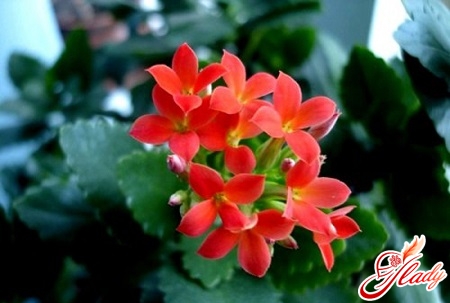
The Benefits of Plants
In the urban environment, we are constantlyhas avitaminosis. Fight it with the help of numerous vitamin and mineral complexes. But if Kalanchoe Degremona lives in your home, the problem of avitaminosis is solved automatically. The leaves of the plant are a real storehouse of useful substances. Here contain and flavonoids, and polysaccharides, and the mass of minerals, and organic acids. Therefore, knowledgeable people consume the leaves of a given flower for food. It is enough to thoroughly wash the sheet and cut it into small pieces - a great additive to any salad is ready. It is especially recommended to use this plant for those who suffer from periodontal disease and gingivitis. The substances contained in it, reduce bleeding gums, remove the inflammatory processes of the mucosa and have a beneficial effect on the condition of the mouth as a whole. As a preventive measure of gum disease, it is possible to spray the mouth with the Kalanchoe juice. To do this, the lower leaves of the plant are torn off, thoroughly washed and cut into small pieces. The juice is squeezed through several layers of gauze or simply through a dense fabric. Irrigation is done in the morning and in the evening - after brushing your teeth. Ideally, before each procedure, you need to prepare fresh juice. But this is not all the useful properties of Kalanchoe. In addition, he is an excellent "biostimulant". A few drops of juice are enough and, probably, the next flu season will pass without you. To prepare a preventive remedy, you need to cut off the leaves of the Kalanchoe and keep them in the refrigerator for two weeks. In such conditions, the plant produces unique substances that can activate many vital processes in the body. Now it is necessary to squeeze out the juice from the leaves, as described above, and use it as needed. Now you know how to grow Kalanchoe Degremona. If you follow the simple recommendations described in this article, a healthy and beautiful plant will settle in your house, which will not only decorate the room, but will also become a home healer in many situations.




